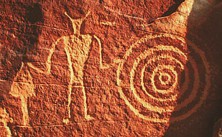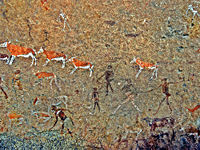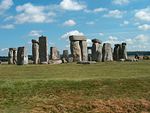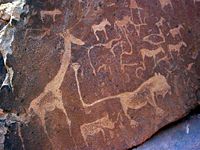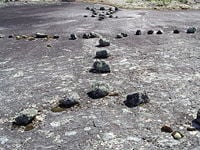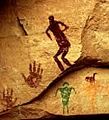Difference between revisions of "Rock art" - New World Encyclopedia
Nick Perez (talk | contribs) |
Nick Perez (talk | contribs) |
||
| Line 14: | Line 14: | ||
*[[Petroglyph]]s - carvings made into stone surfaces, created by rock removal, including scratching, abrading, pecking, carving, drilling, incising and sculpting. Locations of choice are rock facets coated with patina, a dark mineral accumulation on rock surfaces. Petroglyphs remove the patina, exposing the contrasting lighter rock interior. Instances of negative images, produced by removing the patina surrounding the intended figure, are also known. Sometimes petroglyphs are painted or accentuated by polishing. The degree of repatination indicates relative dating. Some of the most ancient petroglyphs are the same color as the surrounding rock. | *[[Petroglyph]]s - carvings made into stone surfaces, created by rock removal, including scratching, abrading, pecking, carving, drilling, incising and sculpting. Locations of choice are rock facets coated with patina, a dark mineral accumulation on rock surfaces. Petroglyphs remove the patina, exposing the contrasting lighter rock interior. Instances of negative images, produced by removing the patina surrounding the intended figure, are also known. Sometimes petroglyphs are painted or accentuated by polishing. The degree of repatination indicates relative dating. Some of the most ancient petroglyphs are the same color as the surrounding rock. | ||
| − | [[Image: | + | [[Image:White Maiden of Brandberg.jpg|thumb|200px|White Lady, Brandberg, Namibia]] |
*[[Pictograph]]s - paintings made on rocks and the inside of [[cave painting|cave]]s. Survival of ancient paintings is attributable to use of mineral pigments, most commonly manganese, hematite, malachite, gypsum, limonite, clays and various oxides. The best preserved pictography is found under sheltering overhangs and in caves. The simplest pictographs are wet clay finger drawings and charcoal drawings. To produce crayons or paints first the minerals had to be finely ground and combined with binding materials. Crayons and animal hair brushes have been excavated in caves with paintings. Exceedingly fine lines evidence the production of excellent brushes. The most common rock art element found around the world, the human hand, exemplifies several pictography types. A technique used since the Neolithic is spraying around a hand, resulting in a negative image. The more common positive print was often made with pigment applied to the hand and transferred to the rock. | *[[Pictograph]]s - paintings made on rocks and the inside of [[cave painting|cave]]s. Survival of ancient paintings is attributable to use of mineral pigments, most commonly manganese, hematite, malachite, gypsum, limonite, clays and various oxides. The best preserved pictography is found under sheltering overhangs and in caves. The simplest pictographs are wet clay finger drawings and charcoal drawings. To produce crayons or paints first the minerals had to be finely ground and combined with binding materials. Crayons and animal hair brushes have been excavated in caves with paintings. Exceedingly fine lines evidence the production of excellent brushes. The most common rock art element found around the world, the human hand, exemplifies several pictography types. A technique used since the Neolithic is spraying around a hand, resulting in a negative image. The more common positive print was often made with pigment applied to the hand and transferred to the rock. | ||
[[Image:Stonehenge-England.jpg|thumb|150px|left|The Stones of Stonehenge]] | [[Image:Stonehenge-England.jpg|thumb|150px|left|The Stones of Stonehenge]] | ||
| − | *[[Petroforms]] - designs,patterns or primitive | + | *[[Petroforms]] - designs,patterns or primitive sculptures made by the aligning or piling of stones. Petroforms include a rock [[cairn]] or [[inukshuk]], an upright [[monolith]] slab, a [[medicine wheel]], a [[fire pit]], a [[desert kite]], or simply rocks lined up or stacked for various reasons. Old World petroforms include the [[Carnac stones]] and many other megalithic monuments, such as the original settings for [[Stonehenge]] and [[Dolmen]]s found around he world.<ref>Kurtz, Patricia A. "As It Is Above, So It Is Below" Native Peoples Magazine [[http://www.nativepeoples.com/article/articles/197/1/Petroforms"Petroforms"]] Retrieved December 4, 2007</ref>Petroforms are made from large rocks and boulders, often over large areas of ground, unlike the smaller petroglyphs and pictographs. |
Traditionally, individual markings are called [[Motif (art)|motif]]s and groups of motifs are known as [[panel]]s. Sequences of panels are treated as [[archaeological site]]s. This method of classifying rock art however has become less popular as the structure imposed is unlikely to have had any relevance to the art's creators. Even the word 'art' carries with it many modern prejudices about the purpose of the features. | Traditionally, individual markings are called [[Motif (art)|motif]]s and groups of motifs are known as [[panel]]s. Sequences of panels are treated as [[archaeological site]]s. This method of classifying rock art however has become less popular as the structure imposed is unlikely to have had any relevance to the art's creators. Even the word 'art' carries with it many modern prejudices about the purpose of the features. | ||
| Line 23: | Line 23: | ||
==Meaning== | ==Meaning== | ||
[[Image:Lion Twyfelfontein Namibia.JPG|thumb|200px|Lion Petroglyph, Twyfelfontein, Namibia]] | [[Image:Lion Twyfelfontein Namibia.JPG|thumb|200px|Lion Petroglyph, Twyfelfontein, Namibia]] | ||
| − | |||
| − | |||
| − | |||
| − | + | What rock art means and why the ancients practiced it has been a bane of contention amongst scholars since the phenomena started to be studied. Many pictographs and petroglyphs depict animals, images of nature and hunting. Some have argued that such images are records of hunts that served not only to inventory the amount of animals killed as well as future references for animal migrating patterns.<ref> Chippindale, Christopher (Ed) and Paul S. C. Taçon (Ed). ''The Archaeology of Rock-Art'', (Cambridge University Press 1998) ISBN 0521576199</ref> | |
| − | + | ||
| − | + | Others argue that there are religious elements to rock art. [[Shamanism]] was the predominate religion when most rock art was created, and so many speculate that in rock art could be the recording of religious practices and beliefs. | |
| + | Common features in rock art that are related to portraying [[shamans]] were [[bones]] and other [[skeletal]] remains on their [[coat]]s. One reason for the bones would be that they were used as a type of [[armor]] for protecting the shaman on his journeys through different worlds. [[Devlet]], the author of ''Rock Art and the Material Culture of Siberian and Central Asian Shamanism'' highlights, “Another interpretation of these skeletal costume elements explains them as representations of a shaman brought back to life after the [[dismemberment]] that occurs during the initiation process: the depicted bones thus refer to the wearer’s own [[skeleton]]."<ref>Ekaterina, Devlet. "Rock Art and the Material Culture of Siberian and Central Asian Shamanism." The Archaeology of Shamanism. 2001 43-54. 01/04/2007 <http://scandinavian.wisc.edu/dubois/Courses_folder/shamanism_readings/2_9_13/Devlet.pdf>.</ref> | ||
| + | [[Image:Petroform 4 by Joseph Prymak 2007 IMGP2129.JPG|thumb|200px|left|Petroform formation]] | ||
| + | Some petroforms may have been used as astronomical calendars, with rocks aligned to solstice and equinox sunrises and sunsets. They are often found in higher areas, on hills, [[mound]]s, ridges, and natural rock formations. Higher ground allowed humans to carefully observe the [[horizon]] to mark and measure astronomical events. Some rock alignments point out four or more directions, lunar events, the rising and setting of planets, the stars, and other astronomical events. Some petroforms can also be used in more complex ways for astronomical predictions, mapping of the sky and ground, and for complex ceremonies that help to memorize many oral stories. Petroforms are similar in some ways to [[medicine wheels]] which are also aligned with sunrises and sunsets, [[equinox]]es, [[solstice]]s, lunar events, and star patterns. Petroforms also mirrored the night sky, and the patterns of the stars, similar to astrological signs and symbols.<ref>Scarre, Chris. ''Megalithic Monuments of Britain and Ireland'', (Thames & Hudson 2007) ISBN 0500286663</ref> The [[Sioux]] have oral stories of the serpent in the sky, a turtle, a bear, and other patterns seen in the stars. What is often known today as [[Orion (constellation)|Orion's belt]] was one prominent star formation, along with the central and stationary north star, now named as [[Polaris]]. What is now known as the planet Venus is the very bright morning and evening star. Other interpretations include geographic markers, hunting aids and, in the case of dolmens, burial structures. | ||
==Gallery== | ==Gallery== | ||
| Line 54: | Line 54: | ||
== References == | == References == | ||
| − | * | + | *Lewis-Williams, J. David, ''A Cosmos In Stone: Interpreting Religion and Society Through Rock Art'', (AltaMira Press 2002) ISBN 0759101965 |
| − | + | *Malotki, Ekkehart and Weaver, Donald E. Jr., ''Stone Chisel and Yucca Brush: Colorao Plateau Rock Art'', (Kiva Publishing Inc. 2002) ISBN 1-885772-27-0 | |
| − | *Malotki, Ekkehart and Weaver, Donald E. Jr. | ||
| − | *Rohn, Arthur H. and Freguson, William M | + | *Rohn, Arthur H. and Freguson, William M, ''Puebloan ruins of the Southwest'', (University of New Mexico Press 2006) ISBN 0-8263-3970-0 |
| − | *Schaafsma, Polly | + | *Schaafsma, Polly, ''Indian Rock Art of the Southwest'', (University of New Mexico press 1980) ISBN 0-8263-0913-5 |
== External links == | == External links == | ||
Revision as of 00:48, 6 December 2007
Rock art is a term in archaeology for any man-made markings made on natural stone; most often it refers to markings and paintings on rocks made by Paleolithic and Mesolithic human beings. The phenomena is thought by many to be the foundations of art as well as an indication of the development of cognitive and abstract ability in the evolution of mankind, as most rock art is thousands of years old, created before the advent of the first major civilizations.[1]
Rock art can be found across a wide geographical and temporal spread of cultures perhaps to mark territory, to record historical events or stories or to help enact rituals. Some art seems to depict real events whilst many other examples are apparently entirely abstract.
Classification
The term rock art can be divided into three distinct categories:
- Petroglyphs - carvings made into stone surfaces, created by rock removal, including scratching, abrading, pecking, carving, drilling, incising and sculpting. Locations of choice are rock facets coated with patina, a dark mineral accumulation on rock surfaces. Petroglyphs remove the patina, exposing the contrasting lighter rock interior. Instances of negative images, produced by removing the patina surrounding the intended figure, are also known. Sometimes petroglyphs are painted or accentuated by polishing. The degree of repatination indicates relative dating. Some of the most ancient petroglyphs are the same color as the surrounding rock.
- Pictographs - paintings made on rocks and the inside of caves. Survival of ancient paintings is attributable to use of mineral pigments, most commonly manganese, hematite, malachite, gypsum, limonite, clays and various oxides. The best preserved pictography is found under sheltering overhangs and in caves. The simplest pictographs are wet clay finger drawings and charcoal drawings. To produce crayons or paints first the minerals had to be finely ground and combined with binding materials. Crayons and animal hair brushes have been excavated in caves with paintings. Exceedingly fine lines evidence the production of excellent brushes. The most common rock art element found around the world, the human hand, exemplifies several pictography types. A technique used since the Neolithic is spraying around a hand, resulting in a negative image. The more common positive print was often made with pigment applied to the hand and transferred to the rock.
- Petroforms - designs,patterns or primitive sculptures made by the aligning or piling of stones. Petroforms include a rock cairn or inukshuk, an upright monolith slab, a medicine wheel, a fire pit, a desert kite, or simply rocks lined up or stacked for various reasons. Old World petroforms include the Carnac stones and many other megalithic monuments, such as the original settings for Stonehenge and Dolmens found around he world.[2]Petroforms are made from large rocks and boulders, often over large areas of ground, unlike the smaller petroglyphs and pictographs.
Traditionally, individual markings are called motifs and groups of motifs are known as panels. Sequences of panels are treated as archaeological sites. This method of classifying rock art however has become less popular as the structure imposed is unlikely to have had any relevance to the art's creators. Even the word 'art' carries with it many modern prejudices about the purpose of the features.
Meaning
What rock art means and why the ancients practiced it has been a bane of contention amongst scholars since the phenomena started to be studied. Many pictographs and petroglyphs depict animals, images of nature and hunting. Some have argued that such images are records of hunts that served not only to inventory the amount of animals killed as well as future references for animal migrating patterns.[3]
Others argue that there are religious elements to rock art. Shamanism was the predominate religion when most rock art was created, and so many speculate that in rock art could be the recording of religious practices and beliefs. Common features in rock art that are related to portraying shamans were bones and other skeletal remains on their coats. One reason for the bones would be that they were used as a type of armor for protecting the shaman on his journeys through different worlds. Devlet, the author of Rock Art and the Material Culture of Siberian and Central Asian Shamanism highlights, “Another interpretation of these skeletal costume elements explains them as representations of a shaman brought back to life after the dismemberment that occurs during the initiation process: the depicted bones thus refer to the wearer’s own skeleton."[4]
Some petroforms may have been used as astronomical calendars, with rocks aligned to solstice and equinox sunrises and sunsets. They are often found in higher areas, on hills, mounds, ridges, and natural rock formations. Higher ground allowed humans to carefully observe the horizon to mark and measure astronomical events. Some rock alignments point out four or more directions, lunar events, the rising and setting of planets, the stars, and other astronomical events. Some petroforms can also be used in more complex ways for astronomical predictions, mapping of the sky and ground, and for complex ceremonies that help to memorize many oral stories. Petroforms are similar in some ways to medicine wheels which are also aligned with sunrises and sunsets, equinoxes, solstices, lunar events, and star patterns. Petroforms also mirrored the night sky, and the patterns of the stars, similar to astrological signs and symbols.[5] The Sioux have oral stories of the serpent in the sky, a turtle, a bear, and other patterns seen in the stars. What is often known today as Orion's belt was one prominent star formation, along with the central and stationary north star, now named as Polaris. What is now known as the planet Venus is the very bright morning and evening star. Other interpretations include geographic markers, hunting aids and, in the case of dolmens, burial structures.
Gallery
- Sanfrancisco paintings.jpg
Rock paintings, Mexico
- Kakadu 2419.jpg
Indigenous Australian rock painting in Kakadu National Park.
Rock Shelters of Bhimbetka rock painting, World Heritage Site
Notes
- ↑ (2000) Roetzel, Kathy ["Rock Art: Dating"] Retrieved December 4, 2007
- ↑ Kurtz, Patricia A. "As It Is Above, So It Is Below" Native Peoples Magazine ["Petroforms"] Retrieved December 4, 2007
- ↑ Chippindale, Christopher (Ed) and Paul S. C. Taçon (Ed). The Archaeology of Rock-Art, (Cambridge University Press 1998) ISBN 0521576199
- ↑ Ekaterina, Devlet. "Rock Art and the Material Culture of Siberian and Central Asian Shamanism." The Archaeology of Shamanism. 2001 43-54. 01/04/2007 <http://scandinavian.wisc.edu/dubois/Courses_folder/shamanism_readings/2_9_13/Devlet.pdf>.
- ↑ Scarre, Chris. Megalithic Monuments of Britain and Ireland, (Thames & Hudson 2007) ISBN 0500286663
ReferencesISBN links support NWE through referral fees
- Lewis-Williams, J. David, A Cosmos In Stone: Interpreting Religion and Society Through Rock Art, (AltaMira Press 2002) ISBN 0759101965
- Malotki, Ekkehart and Weaver, Donald E. Jr., Stone Chisel and Yucca Brush: Colorao Plateau Rock Art, (Kiva Publishing Inc. 2002) ISBN 1-885772-27-0
- Rohn, Arthur H. and Freguson, William M, Puebloan ruins of the Southwest, (University of New Mexico Press 2006) ISBN 0-8263-3970-0
- Schaafsma, Polly, Indian Rock Art of the Southwest, (University of New Mexico press 1980) ISBN 0-8263-0913-5
External links
- RUPESTREWEB / LATIN AMERICAN ROCK ART. Articles, Zones, News, Rock art researchers directory
- Rock Art studies - A Bibliographic database at the Bancroft Library containing over 10,000 citations to the world's rock art literature.
- The website of Rock Art Foundation - Native American Rock Art
- Trust for African Rock Art
- British Rock Art Collection
- ARARA American Rock Art Research Association.
- Rupestre.net A rock art site, mainly devoted to Valcamonica and Alpine Rock Art.
- EuroPreArt The database of European Prehistoric Art.
- Art and Archaeology of the Dampier Archipelago
- Bradshaw Foundation Supports dissemination of information on rock art, migration, and the study of artistic man around the world.
- Rock Art in South Africa http://rockart.wits.ac.za/origins/
- UNESCO World Heritage: Rock Shelters of Bhimbetka
Credits
New World Encyclopedia writers and editors rewrote and completed the Wikipedia article in accordance with New World Encyclopedia standards. This article abides by terms of the Creative Commons CC-by-sa 3.0 License (CC-by-sa), which may be used and disseminated with proper attribution. Credit is due under the terms of this license that can reference both the New World Encyclopedia contributors and the selfless volunteer contributors of the Wikimedia Foundation. To cite this article click here for a list of acceptable citing formats.The history of earlier contributions by wikipedians is accessible to researchers here:
The history of this article since it was imported to New World Encyclopedia:
Note: Some restrictions may apply to use of individual images which are separately licensed.
